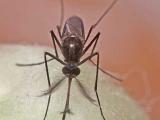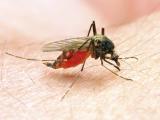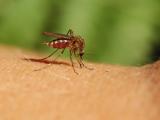Sep 18, 2003 (CIDRAP News) A new blood test for West Nile virus (WNV) is not foolproof but has made the blood supply safer now than it was a year ago, the Centers for Disease Control and Prevention reported today.
The technique, a nucleic acid amplification test, has detected the virus in 601 blood donations so far this season, the CDC reported. Thus far only two cases of West Nile transmission have been linked to blood transfusions, compared with 23 cases last year.
"The blood supply is safer than it was a year ago . . . but we are still on the lookout for an occasional case that could slip through," CDC Director Julie Gerberding said during a news teleconference today.
"It's a very low risk but not a zero risk," she said. For patients who need blood, she added, "The risk of West Nile, though not zero, is generally not large enough to contraindicate the transfusion."
Last year, 23 people acquired West Nile virus from transfused blood components (red cells, platelets, or fresh-frozen plasma), according to a report published online today by the New England Journal of Medicine. Ten of the recipients were immunocompromised because of cancer or transplantation, and eight were older than 70. The contaminated blood was traced to 16 donors, of whom 9 had viral symptoms, 5 had no symptoms, and 2 were lost to follow-up.
Gerberding praised the Food and Drug Administration (FDA) for "incredibly quickly" developing the nucleic acid test. She explained that the test is used on blood pooled from either 6 or 16 donors. "If the test is found to be positive, the individual donors are then evaluated and the blood is not used for transfusion," she said.
The 601 blood donations that have tested positive for WNV so far this year were among about 2.5 million donations that were screened from June through mid-September, the CDC reports today in MMWR Dispatch, a supplement to Morbidity and Mortality Weekly Report. Final test results on 209 other donations are still awaited, the report says.
Dr. Jesse Goodman of the FDA, commenting on the removal of the 601 units of contaminated blood from the blood supply, said, "Since these go to on the order of two recipients per unit, we can assume we've already prevented a large number of infections" as well as some illness cases.
Gerberding said researchers tested how pooling blood from multiple donors affects the reliability of the nucleic acid test. They found that, because of dilution, "on very rare occasions the virus concentration was too low to be found in the mixed pool" but did show up in individual blood samples, she said. "So this is a major step forward but it's not perfect . . . and clinicians need to be on the lookout for symptoms in blood transfusion recipients."
"We are recommending that in areas where it's feasible to do individual donor testing, that be done, and in fact several states are already doing that," Gerberding said. "Many of the blood suppliers are able to do that, but it's not possible to do that at every blood center around the country." The MMWR Dispatch article recommends individual blood screening in areas with high rates of infection among donors and says that is being done at some blood banks in Kansas, Nebraska, North Dakota, Oklahoma, and South Dakota.
States that have had more than 50 viremic blood donations this year include Colorado, with 154; Nebraska, 116; and South Dakota, 56, according to the CDC report. Among 333 donors from the hardest-hit areas for whom information was available, 296 (89%) were asymptomatic after giving blood, 35 (11%) had West Nile fever, and 2 (0.7%) had West Nile meningoencephalitis.
The two patients with WNV infections linked to blood transfusions were a 71-year-old Texas man and an 80-year-old Nebraska man, according to MMWR Dispatch. Both men were recovering as of Sep 16, the report says.
Gerberding warned today that the WNV season isn't over. "Although the news may be reporting that we're past the peak, it's certainly not over yet and people need to take steps to protect themselves," she said. She added that cases of West Nile encephalitis have increased this year and that improved diagnostic ability has contributed to an increase in the number of reported West Nile fever cases.
During the week of Sep 11 through 17, 1,214 cases of WNV, including 26 deaths, were reported from 28 states, according to a report in the Sep 19 issue of MMWR. That compares with 1,067 cases and 17 deaths the previous week. The latest cases bring the 2003 total to 4,137 cases and 80 deaths, the report says. Last year there were 4,156 cases and 284 deaths.
Colorado continued to be the hardest-hit state, with a total of 1,542 cases, up from 973 the week before. Other states with large outbreaks were South Dakota, 580 cases; Nebraska, 543; Wyoming, 282; Texas, 276; Montana, 154; North Dakota, 126; and New Mexico, 124.
See also:
Pealer LN, Marfin AA, Petersen LR, et al. Transmission of West Nile virus through blood transfusion in the United States in 2002. N Engl J Med 2003; 2003 Sep 25;349(13):1236-45 (published online Sep 18)] [Abstract]
CDC. Update: detection of West Nile virus in blood donationsUnited States, 2003. MMWR Dispatch 2003 Sep 18;52(Dispatch) [Full text]
CDC. West Nile virus activityUnited States, September 11-17, 2003. MMWR 2003;52(37):889-90 [Full text]

















